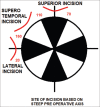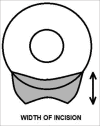Postoperative astigmatic considerations in manual small-incision cataract surgery - A review
- PMID: 36308097
- PMCID: PMC9907315
- DOI: 10.4103/ijo.IJO_1627_22
Postoperative astigmatic considerations in manual small-incision cataract surgery - A review
Abstract
Cataract remains a major cause of visual impairment worldwide including in India. The sutureless manual small-incision cataract surgery (MSICS) as an alternative to phacoemulsification, gives equivalent visual results at lower expenses. Still the procedure is often discredited for higher astigmatism due to the larger size of the incision. High astigmatism is an important cause of poor uncorrected visual acuity after cataract surgery. However, there are enough studies in the literature to prove that surgically induced astigmatism (SIA) can be minimized and also eliminated by adopting appropriate wound construction techniques during surgery. Even pre-existing astigmatism if any can be neutralized by changing wound architecture during surgery. Here, we review the various techniques of scleral tunnel construction described in the literature to care for postoperative astigmatism in MSICS.
Keywords: Astigmatism; cataract; manual small-incision cataract surgery.
Conflict of interest statement
None
Figures
Similar articles
-
Factors affecting surgically induced astigmatism in manual small-incision cataract surgery.Indian J Ophthalmol. 2022 Nov;70(11):3779-3784. doi: 10.4103/ijo.IJO_1034_22. Indian J Ophthalmol. 2022. PMID: 36308096 Free PMC article. Review.
-
Visual outcome after manual small-incision cataract surgery by viscoexpression technique.Indian J Ophthalmol. 2022 Nov;70(11):3933-3937. doi: 10.4103/ijo.IJO_1582_22. Indian J Ophthalmol. 2022. PMID: 36308130 Free PMC article.
-
Evaluation of scleral incisions and their effects on corneal curvature in manual small-incision cataract surgery.Indian J Ophthalmol. 2022 Nov;70(11):3854-3857. doi: 10.4103/ijo.IJO_1618_22. Indian J Ophthalmol. 2022. PMID: 36308112 Free PMC article. Clinical Trial.
-
Comparative study of anatomical and functional recovery of eye along with patient satisfaction score after small-incision cataract surgery and phacoemulsification cataract surgery.Indian J Ophthalmol. 2022 Nov;70(11):3942-3947. doi: 10.4103/ijo.IJO_1614_22. Indian J Ophthalmol. 2022. PMID: 36308132 Free PMC article. Clinical Trial.
-
Toric intraocular lens versus limbal relaxing incisions for corneal astigmatism after phacoemulsification.Cochrane Database Syst Rev. 2019 Dec 17;12(12):CD012801. doi: 10.1002/14651858.CD012801.pub2. Cochrane Database Syst Rev. 2019. PMID: 31845757 Free PMC article.
Cited by
-
Evaluation of the better operative outcome software tool to predict cataract surgical outcome in the early postoperative follow-up.BMC Ophthalmol. 2023 Jul 13;23(1):317. doi: 10.1186/s12886-023-03058-1. BMC Ophthalmol. 2023. PMID: 37442998 Free PMC article.
-
Surgical approaches to correct corneal astigmatism at time of cataract surgery: a mini-review.Int J Ophthalmol. 2024 Jul 18;17(7):1370-1374. doi: 10.18240/ijo.2024.07.23. eCollection 2024. Int J Ophthalmol. 2024. PMID: 39026920 Free PMC article. Review.
-
"Stamp the tunnel"- Innovative tool - for perfection in manual small incision cataract surgery.Indian J Ophthalmol. 2024 Sep 1;72(9):1382. doi: 10.4103/IJO.IJO_2252_23. Epub 2024 Aug 23. Indian J Ophthalmol. 2024. PMID: 39185842 Free PMC article.
-
Effectiveness of the Better Operative Software Outcomes Tool for Monitoring Cataract Surgery Outcomes in Inhambane Province, Mozambique: Prospective Pilot Diagnostic Accuracy Study.JMIR Mhealth Uhealth. 2025 May 21;13:e64500. doi: 10.2196/64500. JMIR Mhealth Uhealth. 2025. PMID: 40397505 Free PMC article.
-
Corneal Biomechanics and Other Factors Associated with Postoperative Astigmatism after Cataract Surgery.Life (Basel). 2024 May 21;14(6):655. doi: 10.3390/life14060655. Life (Basel). 2024. PMID: 38929639 Free PMC article.
References
-
- Venkatesh R, Chang DF, Muralikrishnan R, Hemal K, Gogate P, Sengupta S. Manual small incision cataract surgery:A review. Asia-Pac J Ophthalmol. 2012;1:113–9. - PubMed
-
- Ruit S, Tabin G, Chang D, Bajracharya L, Kline DC, Richheimer W, et al. A prospective randomized clinical trial of phacoemulsification vs manual sutureless small-incision extracapsular cataract surgery in Nepal. Am J Ophthalmol. 2007;143:32–8.e2. - PubMed
-
- Pershing S, Kumar A. Phacoemulsification versus extracapsular cataract extraction:Where do we stand? Curr Opin Ophthalmol. 2011;22:37–42. - PubMed
-
- Venkatesh R, Tan CSH, Sengupta S, Ravindran RD, Krishnan KT, Chang DF. Phacoemulsification versus manual small-incision cataract surgery for white cataract. J Cataract Refract Surg. 2010;36:1849–54. - PubMed
-
- Gogate P, Deshpande M, Nirmalan PK. Why do phacoemulsification?Manual small-incision cataract surgery is almost as effective, but less expensive. Ophthalmology. 2007;114:965–8. - PubMed
Publication types
MeSH terms
LinkOut - more resources
Full Text Sources
Medical






